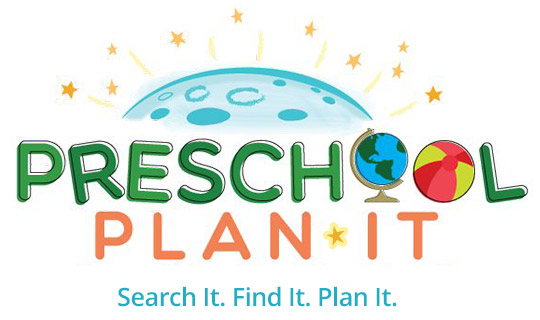
Home | About | Contact | Preschool Cubby Member Login
- Theme Packs
- All Themes - Alphabetical
- Month by Month Themes
- Holiday Themes
- Bible Themes
- Fall Themes
- Winter Themes
- Spring Themes
- Summer Themes
- Planning Activities 101
- Planning Themes 101
- Circle Time
- Dramatic Play
- Gross Motor
- Health/Nutrition
- Plan Preschool Graduation
- Plan Preschool Concerts & Plays

Preschoolers
- Growth & Development
- Developmental Milestones
- Behavior Guidance
- Special Needs
- School Readiness
- Preschool Family Life Events
- Toddler Tips
Teacher Development
- New Teacher Tips
- Parent Communication
- Professional Development
- Teaching Tips & Tricks
- The Classroom
- Interest Centers
- Classroom Pets
- Bulletin Board Ideas
- Director Home
Preschool Cubby
- Product Reviews
Dental Health Theme for Preschool

This Dental Health Preschool Theme page is filled with preschool activities and ideas for all areas of your classroom.
Dental Care is but one of the personal and social development learning areas for preschoolers.
You'll find more themes to help you with your planning on my preschool themes page .
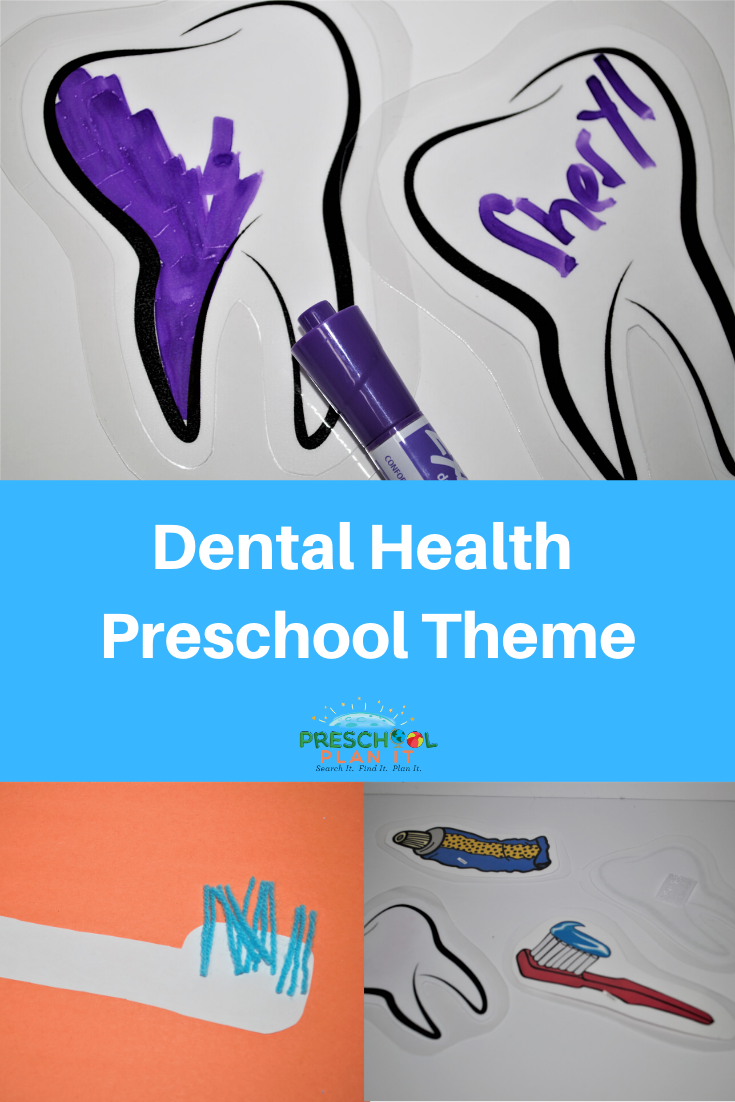
Preschoolers are learning about themselves as individuals, as family members and as part of their classroom group.
This theme helps them to develop positive habits and skills that will last a lifetime
Let the Dental Health Theme Planning Begin!
You can either scroll down through this page to see all of the preschool lesson plans for this theme.
Or click the picture links below to go to specific preschool activity types you are looking for.
Dental Health Theme Art

Tooth Brushes
Materials Needed: pre-cut toothbrush handles on white construction paper; pieces of yarn; crayons; glue
Children decorate the handle. They then glue the yarn on as bristles.
Tooth Printing
Materials Needed: Tooth shaped stamps*, white paint; various colors of construction paper
*If you don't have tooth shaped stamps, make them by cutting out tooth shapes from foam. Glue that to a wooden block!
Children dip stamps into paint and make a dental health picture.
VARIATION: Also make stamps for toothpaste tubes, tooth brushes, floss, etc.
Return to Top
Dental Health Theme Block Center Ideas
Going To the Dentist
Provide cars, a car/ road mat or carpet and little people for the children to act out driving to the dentist office, building a dentist office,etc.
Dental Health Theme Circle Time Ideas
Circle Time is such a great time for children to learn the social skills of being together as a large group AND to learn more about your Dental Health Theme!
Dentist Visit:
Invite a Dentist or Dental Hygienist to visit the classroom and discuss Dental Health. Have questions prepared in advance from the children including all the questions they have about teeth!
Healthy or Not Healthy for Teeth?
Turn 2 small boxes into faces (tape on a drawn face). Cut out the mouths of each. Make one smiling and one sad. The children place the foods into the happy face if the food is good for you and the frowning face if it is not.
How I Brush My Teeth Fingerplay
Make up your own hand motions to go with the lines!
Up and down and all around.
That's the way I brush my teeth.
I brush my gums and shining fronts
Then I reach up underneath
I rinse my brush and place it
In my space to dry
And put the cap on the toothpaste tube
At least I try!
Then I look into the mirror and I grin
To show myself how good a brusher I've been.
Snack Recipe Ideas to Cook Up for Your Dental Health Theme!
Cooking with children helps develop their math skills and helps them to learn how to follow directions. It also allows for some great conversation! Ask many questions while cooking with your children to encourage conversation! Be sure to ask specific theme questions while making these fun snacks!
Grape Yogurt Snack
Ingredients and Items Needed: fruit flavored yogurt (2 or 3 different flavors); seedless grapes; small paper cups; tablespoons; plastic knives.
Discuss with children that milk products are good for our teeth because it has something called calcium in it and that gives us strong teeth and strong bones!
The children cut up 4 grapes.
They scoop a tablespoon or 2 of each type of yogurt into their cup.
They put the grapes on top!
Dental Health Theme Ideas to Transform Your Dramatic Play Area
Dental Health Office
DENTAL RECEPTION OFFICE
Table, play telephone, clipboard, pens, pencils, dolls, stuffed animals, dental books
Like this theme so far? Receive a free theme starter pack on the 1st of each month AND awesome preschool teacher planning articles and ideas when you join my Preschool Teacher Tips Email Community: It's Free to Join!
Themed Ideas for your Easel--More Than Just Painting (Although that is always THE favorite in our classroom!)
Tooth Themed Painting
Encourage the children to paint pictures of teeth, going to the dentist, their family smiling, etc.
Dental Health Theme Large Group Games to Help Your Preschoolers Build Their Muscles While They Have Fun Together!
Drop the Brush Into the "Mouth"
One teacher had large mouth plastic containers (like juice containers) and had the children try to drop the toothbrushes into the container by holding the toothbrush about an inch or so over the opening!
Dental Health Theme Ideas for Your Library and Literacy Activities for your Preschool Classroom
Book Suggestions for the Library
Flannel Pieces
In the library, provide a flannel board. Have dental health flannel pieces available for them to use while reading books, singing songs you have taught them during this theme or just to use while talking about their own experiences! Have flannel pieces such as toothbrushes, teeth, toothpaste, toothpaste cap, floss, healthy foods, dentist, dentist chair, etc.
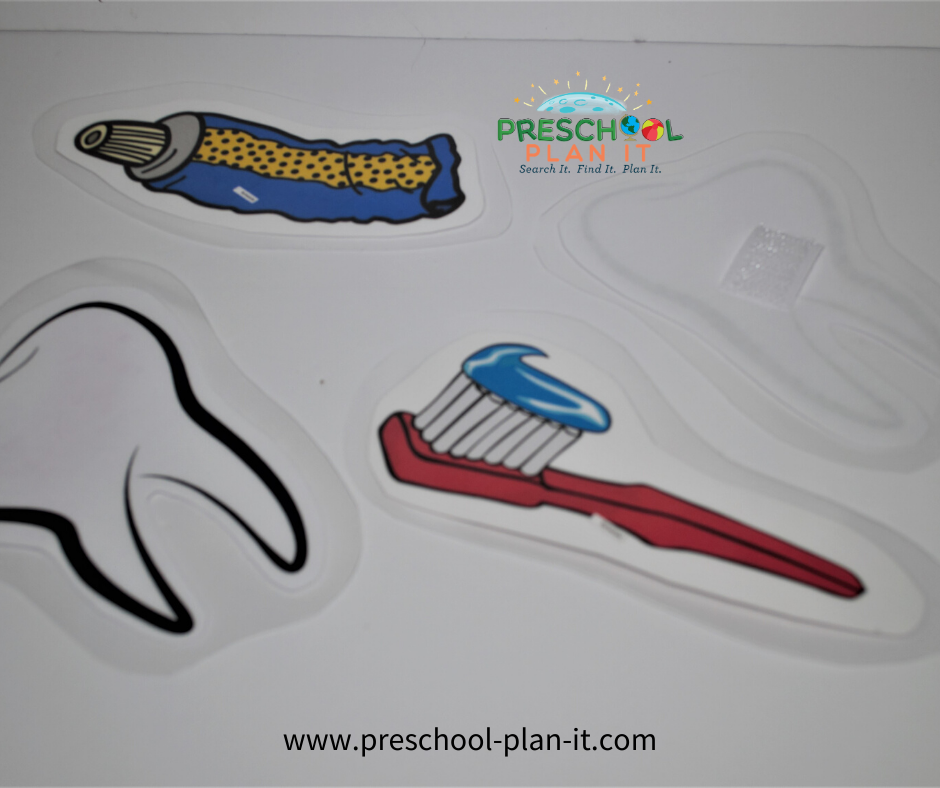
Dental Health Theme Math Activities to Help Your Preschoolers Develop Their Math Skills and the Small Muscles in Their Hands!
Lace A Tooth
Materials Needed: Tooth shapes cut out of colored poster board; colored laces, hole punch
If you don't have tooth shape lacing cards, make them! Cut out a tooth shape from colored poster board. Hole punch around the edges. Provide laces with a knot in one end.
Provide other dental health items as lacing cards such as floss shapes, toothpaste, etc.
How Many Teeth?
Materials Needed: Hand mirrors, paper, crayon or marker. Let them try and count how many teeth they have!
EXTENSION: Have a paper with each child's name on it (or, encourage them to write their own names). Have number cards. Encourage them to write the number of teeth they have on top on their paper. Post on a chart of How Many Teeth in your classroom.
Count the Teeth
Materials Needed: pink playdough and small craft sticks
Have children manipulate playdough into an oval shape. Give them each 20 small craft sticks. Tell them that children have 20 teeth, called baby (or deciduous) teeth. They then count out and place 20 sticks into their playdough gums!
Adults have 32 adult teeth, including wisdom teeth! Perhaps they would like to count to 32!
Dental Health Theme Music and Movement Activities and Ideas to Get Your Preschoolers Movin' and Groovin'!
Like What You See So Far? Join my FREE Preschool Teacher Tips Email Community today and receive: Weekly tips and planning ideas! And, on the 1st of each month I'll email you a free theme starter pack that includes a printable activity mat or game, Calendar pieces, a playdough recipe and a song poster! Join NOW and I'll also send you the theme planning forms I use! It's all FREE? You in? Just tell me where to send your goodies below!
Brush Your Teeth Song sung to the tune of Row, Row, Row Your Boat
Brush, brush, brush your teeth,
Brush the germs away!
Happy, healthy teeth you'll have,
By brushing everyday!
Floss, floss, floss your teeth,
Floss the germs away.
Happy, healthy gums you'll have,
By flossing every day!
Healthy Teeth Song sung to the tune of Row, Row, Row Your Boat
Eat, Eat healthy foods
Eat some every day
If you do, "I Love You"
is what your teeth would say!
Brush, brush, brush your teeth.
Brush them every day!
Brush the fronts and brush the backs
And clean your teeth will stay!
Visit, Visit, Visit the dentist,
two times every year!
The dentist helps your teeth stay healthy
So you can smile from ear to ear!
Dental Health Activities for the Sand and Water Table!
Brushing Teeth
Add toothbrushes to your water table. Add small baby dolls that are smiling to brush teeth! Or, add the foam egg cartons and pretend they are alligator teeth for them to brush (and scoop water with!).
Dental Health Theme Science Activities--for Your Preschool Scientists in Training!
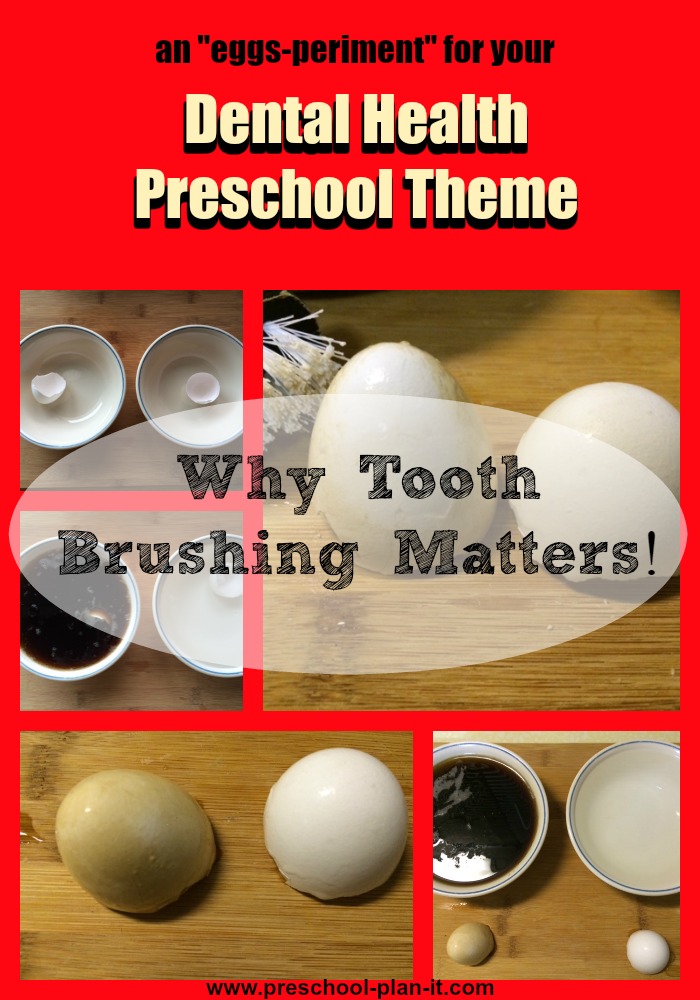
Dental Health Tooth Experiment Thanks, Pam, for this suggestion!
Use 2 clear cups, 2 eggs, vinegar, cola, toothbrush, toothpaste, and a magnifying glass.
- Soak an egg in a cup of cola and a second one in vinegar.
- Overnight the eggs will turn brown and the other one will lose it's shell.
- The cola one can show what happens if you don't brush (It will come off with a toothbrush and toothpaste).
- The second one shows that if the acid continually builds up in your mouth, it will decalcify, just like the egg.
Tooth Brushing Thank you, Pam, for this idea!
Use the bottom of liter soft drink bottle cut off and painted white. Provide old toothbrushes to practice brushing!
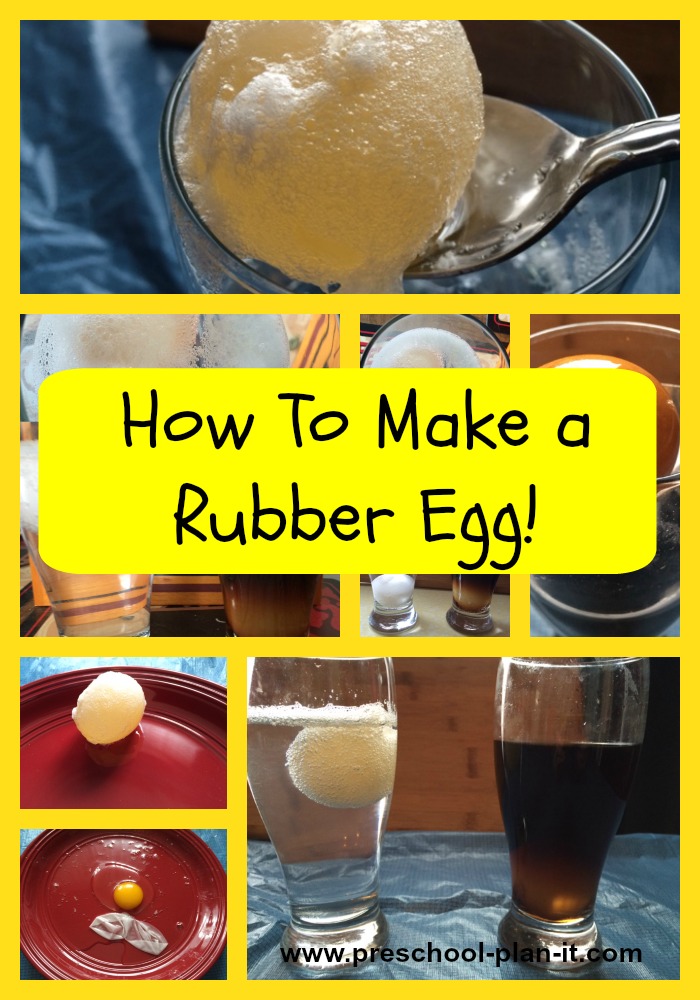
Acidic Teeth
Materials Needed: 1 hard boiled egg; glass jar; white vinegar
Tell the children that some foods are what we call "acidic" and can hurt the enamel of our teeth.
- Place the egg in a jar and pour in enough vinegar to cover the egg.
- Let sit for 24 hours. Children should observe it throughout the day. They will see small bubbles forming on the eggshell.
- The next day, take out the egg and rinse it.
All of the eggshell will be gone. The vinegar is an acid that decalcifies the egg shell much like acids in food do on our teeth.
Here's my video demonstration:
Writing Activity Ideas for Your Preschool Classroom's Dental Health Theme!
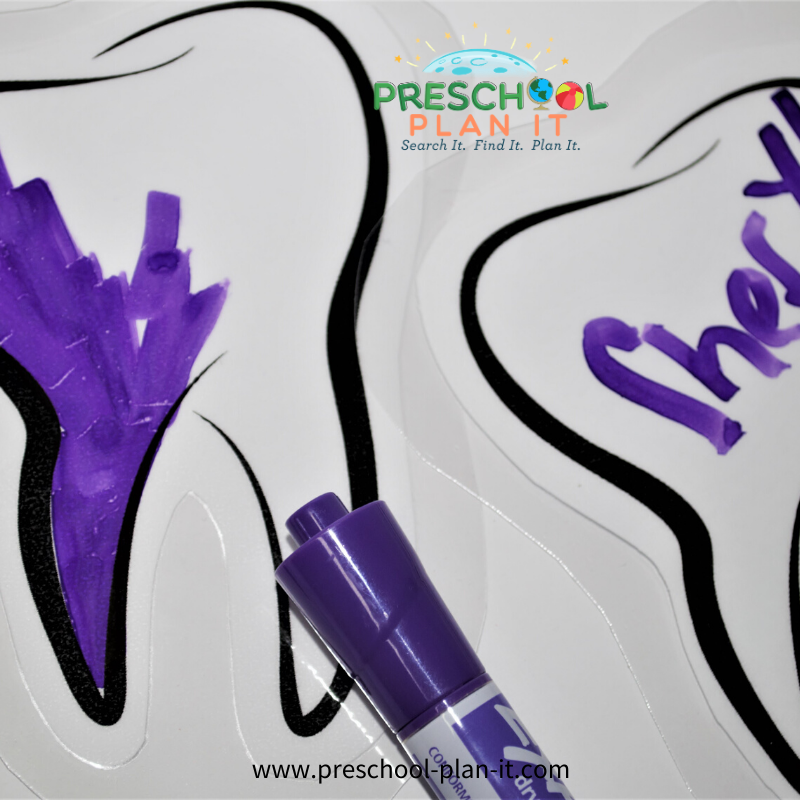
Tooth tracing and Dental Health Words
Materials needed: Provide tooth shapes (made on cardboard or manila folders for durability); markers or colored pencils; scissors; dental health word cards (such as index cards with the words and pictures on them of: TOOTH, DENTIST, CAVITY, BRUSH, etc.).
The children trace and cut out their teeth. They can decorate with markers or colored pencils and write words on it as well!
Magic Teeth
Materials Needed: Tooth shapes you have cut out and laminated; low-odor dry erase markers
Provide these materials at your writing table. Encourage the children to write their names, draw, etc. They can erase their writing with a facial tissue and use over and over again!
Dental Health Miscellaneous Activities
Dental Office Field Trip
Yup, you knew it was coming! Visit the dental office! If you can not arrange this with your group, invite a periodontics dentist or hygienist to visit your center. Offer for them to give you brochures about their office so that you can sent them home with the children (free advertising for them!).
Brushing Chart
Encourage children to brush their teeth by printing and sending home a chart.
Colgate has a cute, free chart you can print out! CLICK HERE to check it out!
EXTENSION: Send the chart home and ask that they bring it back completed in a week!
Don't forget to sign up for my FREE Preschool Tips Email Community! You'll receive a weekly article to help support you in your work with preschoolers AND A theme starter pack on the 1st of each month! All free! Just tell me below where to start sending your goodies!
Other Themes You May Be Interested In:

Go to the main THEMES PAGE for more theme ideas!
Go to Preschool Plan It's Home Page

Testimonials
Privacy Policy

Hey there! Welcome to Preschool Plan It! I’m Cheryl, a preschool teacher of over 20 years.
I KNOW, I know , you spend hours of time developing your preschool themes, activities and preschool lesson plans each week. You are commited to planning preschool themes and activities that are engaging hands-on, interactive, fun AND meet the goal of supporting each child’s level of growth and development.
I am commited to providing you, the preschool teacher, with everything you need to develop preschool lesson plans and preschool activities for your classroom all in one place!
Join My Free Preschool Teacher Tips Newsletter
You’ll receive a weekly email with planning tips and teaching ideas. You'll also receive (on the 1st of each month) a free theme starter pack with some printables and activity ideas to get you started planning a theme!
Join Now and Get Your First Theme Right Away!
© Copyright 2010-2024 Preschool-Plan-It.com | All Rights Reserved | Privacy Policy & Disclaimer
- Second Opinion
A Child's First Dental Visit Fact Sheet
When should your child first see a dentist? You can take your child at a younger age, but experts recommend taking him or her within 6 months of the first tooth coming in (erupting), or by about 12 months at the latest.
At this time, the dentist can give you information on:
Baby bottle tooth decay
Infant feeding practices
Mouth cleaning
Pacifier habits
Finger-sucking habits
Prepare your child
If possible, schedule morning appointments so young children are alert and fresh.
Prepare a preschooler or older child for the visit by giving him or her a general idea of what to expect. Explain why it is important to go to the dentist. Build excitement and understanding.
Prepare yourself
Discuss your questions and concerns with the dentist. Remember that your feeling toward dental visits can be quite different from your child's. Be honest with your view of the dentist. If you have dental anxieties, be careful not to relate those fears or dislikes to your child. Parents need to give moral support by staying calm while in the dental exam room. Children can pick up parents' anxieties and become anxious themselves.
Prepare the dentist
At the first visit, give the dentist your child's complete health history. For a restoration visit, such as getting a cavity filled, tell the dentist if your child tends to be stubborn, defiant, anxious, or fearful in other situations.
Watch how your child reacts. Many parents are able to guess how their child will respond and should tell the dentist. Certain behaviors may be linked to your child's age:
10 to 24 months. Some securely attached children may get upset when taken from their parents for an exam.
2 to 3 years. A securely attached child may be able to cope with a brief separation from parents. In a 2-year-old, "no" may be a common response.
3 years. Three-year-olds may not be OK being apart from a parent when having a dental procedure such as getting a cavity filled. This is because most 3-year-olds are not socially mature enough to separate from parents.
4 years. Most children should be able to sit in another room from parents for exams and treatment procedures.
The first visit
Your child's first dental visit is to help your child feel comfortable with the dentist. The first dental visit is recommended by 12 months of age, or within 6 months of the first tooth coming in. The first visit often lasts 30 to 45 minutes. Depending on your child's age, the visit may include a full exam of the teeth, jaws, bite, gums, and oral tissues to check growth and development. If needed, your child may also have a gentle cleaning. This includes polishing teeth and removing any plaque, tartar, and stains. The dentist may show you and your child proper home cleaning such as flossing, and advise you on the need for fluoride. Baby teeth fall out, so X-rays aren’t often done. But your child's dentist may recommend X-rays to diagnose decay, depending on your child's age. X-rays are also used to see if the root of a jammed baby tooth may be affecting an adult tooth. In general, it is best that young children not have dental X-rays unless absolutely needed.
The second visit
Just like adults, children should see the dentist every 6 months. Some dentists may schedule visits more often, such as every 3 months. This can build comfort and confidence in the child. More frequent visits can also help keep an eye on a development problem.
Protect your children's teeth at home
Here are some tips to protect your children's teeth:
Before teeth come in, clean gums with a clean, damp cloth.
Start brushing with a small, soft-bristled toothbrush and a very small amount of toothpaste (the size of a grain of rice) when your child's first tooth appears. Use a pea-sized dab of fluoridated toothpaste after 3 years of age. This is when the child is old enough to spit out the toothpaste after brushing.
Prevent baby bottle tooth decay. Don't give children a bottle of milk, juice, or sweetened liquid at bedtime or when put down to nap.
Limit the time your child has a bottle. Your child should empty a bottle in 5 to 6 minutes or less.
Help your child brush his or her own teeth until age 7 or 8. Have the child watch you brush, and follow the same brushing pattern to reduce missed spots.
Limit foods and treats that increase tooth decay. This includes hard or sticky candies, fruit leather, and sweetened drinks and juice. Offer fruit rather than juice. The fiber in fruit tends to scrape the teeth clean. Juice just exposes the teeth to sugar.
- The Neonatal Intensive Care Unit (NICU)
- Fluoride and Children
- Dental Emergencies
Related Topics
Dental Care for Infants and Children
Adolescent Problems of the Teeth and Mouth
Connect with us:
Download our App:
- Leadership Team
- Vision, Mission & Values
- The Stanford Advantage
- Government and Community Relations
- Get Involved
- Volunteer Services
- Auxiliaries & Affiliates
© 123 Stanford Medicine Children’s Health
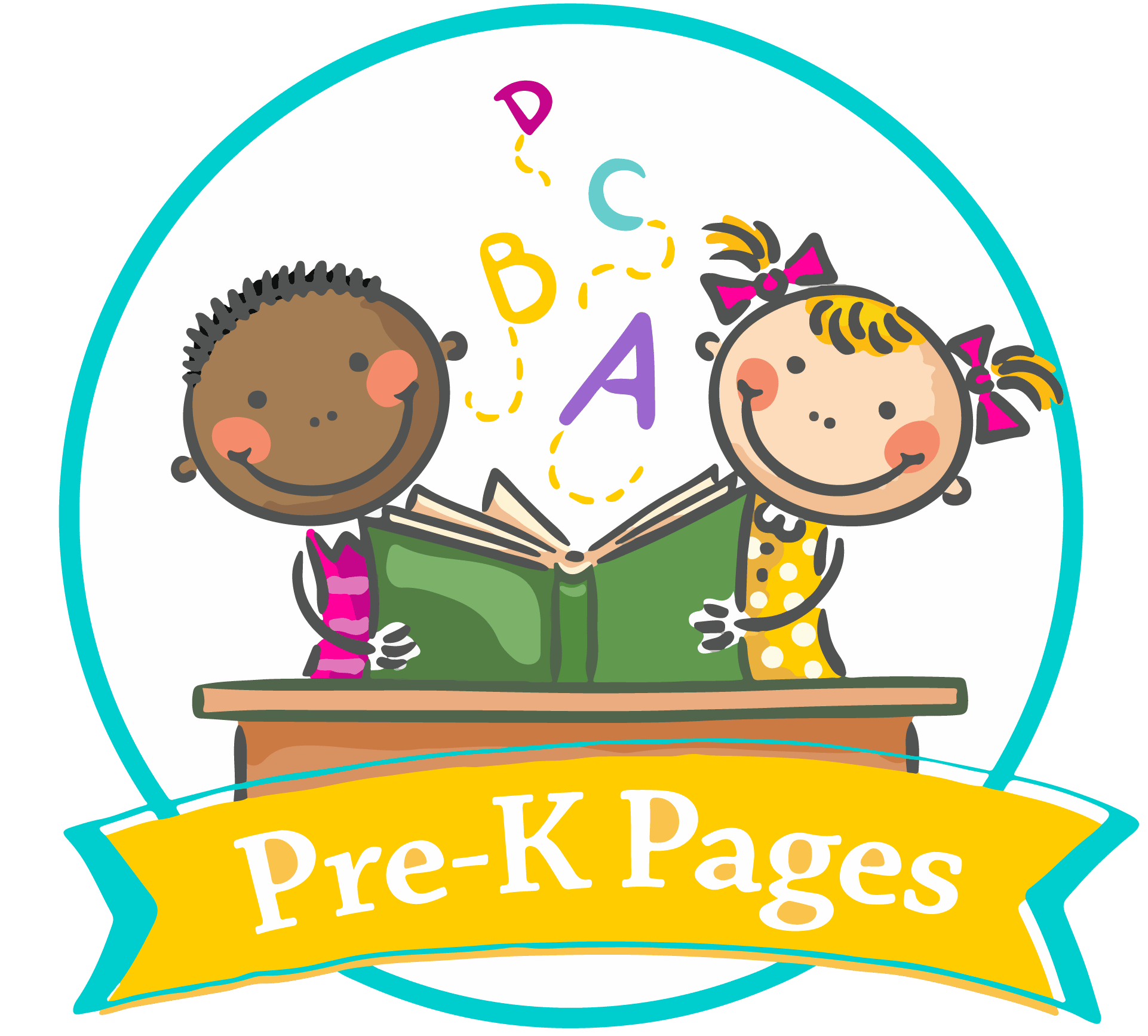
Ready to Make Circle Time Amazing?
Sign up for our FREE newsletter and receive my ebook 7 Circle Time Mistakes
Thanks for subscribing! Please check your email for further instructions.
Activities for a Dental Health Theme in Preschool
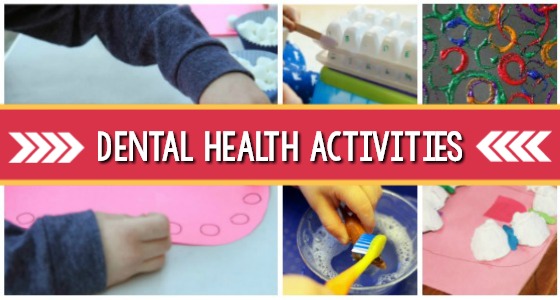
February is Dental Health Month. Preschoolers are just beginning to form healthy habits. Exploring teeth, dentists, and related topics helps them begin to understand the importance of caring for themselves.
They can also begin to learn about the people in the community who help with dental care.
Here are more than 20 activities to provide opportunities for preschoolers to learn more about their bodies and about dental health .
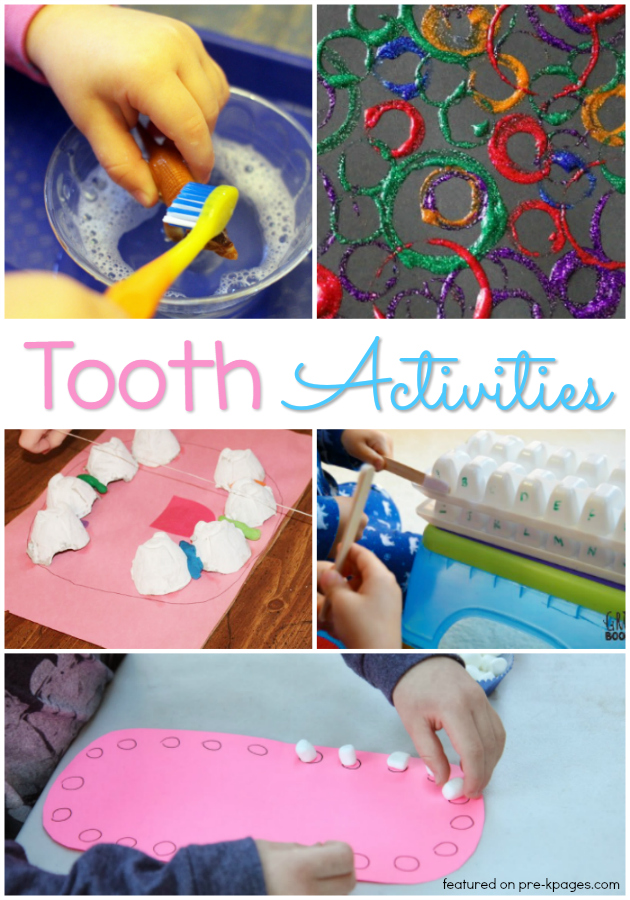
Activities for Dental Health Theme
Dental Health Science Experiment (Pre-K Pages) – We explored this fun Dental Health Science Experiment that emphasized the effects of different drink choices on our teeth and the importance of brushing.
Dental Health Play Dough Tray (Pre-K Pages) – This play dough tray encourages preschoolers to build “mouths” and think about teeth.
Books About Dentists (Pre-K Pages) – Reading books about dentists and their helpful work can create more positive attitudes in preschoolers. These books are perfect for talking about dentists and would be great additions to your classroom.
Dental Health Process Art (Pre-K Pages) – Provide a few basic resources and allow your preschoolers to create and explore teeth and dental health.
Activities for Dental Health Theme (Pre-K Pages) – From books, to literacy activities, to syllables activities there is plenty for your dental theme in your classroom!
Toothbrush Practice (Teach Preschool) – Your students will be discuss dental hygiene while they get in a little tooth brushing practice. Your students will have fun with tooth brush water play in this activity!
Dental Health Sensory Play (Still Playing School) – Using a play doh dentist kit, your pre-K or kindergarten students will enjoy that they get to see, hear, smell, taste, and touch the toothpaste!
Make a Model Mouth (Teaching Mama) – Create a model of a mouth out of construction paper and marshmallows. Your students can practice placing the glue on the circles for the teeth.
Brush Away Alphabet Germs (Growing Book by Book) – This activity practices letter identification and learning about the importance of proper teeth brushing. We also have a fun song to sing while playing.
Toothpaste Slime (Still Playing School) – Your preschoolers and kindergartners will have fun playing with slime that looks just like toothpaste for Dental Health Month. It is the perfect material to invite kids to explore for fine motor, sensory, and pretend play!
Flossing Activity (Teaching Mama) – With this hands on activity your students will get excited about flossing.
Learn To Brush Teeth With Eggs (Teaching Mama) – Using hardboiled eggs and various liquids, your students can practice brushing teeth with this activity.
Elephant Toothpaste (Teach Preschool) – Everyone will love this science activity to go along with your dental theme lessons.

Activities for a Dental Health Theme
Paint a Tooth (Play to Learn Preschool) – This simple activity of painting a tooth white is a fun way to emphasize dental health. This post includes a poem to add to the completed teeth.
Painting with Toothbrushes (Mom to 2 Posh Lil Divas) – Students will enjoy painting these large teeth!
Dentist Play Dough Pretend Play (Fantastic Fun and Learning) – In this activity, your students will enjoy getting to play dentist while also working on their fine motor skills.
Flossing Activity With Egg Carton (Meet Penny) – Using an egg carton, your preschoolers will be able to practice flossing. Using a teeth anatomy worksheet, they will be able to learn the different names of the teeth and their functions.
Electric Toothbrush Painting (Teach Beside Me) – Use old toothbrushes to make some beautiful art!
Dinosaur Scrubbing (Sugar Spice and Glitter) – Your little ones will see the importance of scrubbing with these toy dinosaurs.
Toothpaste Caps Circle Art (School Time Snippets) – Create art by using old toothpaste caps and glitter paint!
Science Experiment: What Do Sugary Drinks Do to Your Teeth? (Feels Like Home) – Learn the importance of brushing in this fun visual science experiment with eggs.
Liquid Chalk and Toothbrushes (Glued to My Crafts) – Just a few simple ingredients and you can make liquid chalk and use toothbrushes to create art.
Books and Activities for Dental Health Theme (Kindergarten Chaos) – This ultimate list of books and activities will be super helpful when it’s National Children Dental Health month.
Dental Heath Activities for Beginning Readers (Teaching Mama) – These simple sentences and syllable activities will support your early readers.
Also check out Dental Health Literacy Activities and Dental Health Math Activities in our store.
Links for Dental Health

- September 2024
- August 2024
- February 2024
- January 2024
- December 2023
- November 2023
- October 2023
- September 2023
- August 2023
- January 2023
- December 2022
- November 2022
- October 2022
- September 2022
- August 2022
- February 2022
- January 2022
- November 2021
- October 2021
- August 2021
- November 2020
- October 2020
- September 2020
- August 2020
- February 2020
- January 2020
- December 2019
- October 2019
- September 2019
- August 2019
- January 2019
- Entries feed
- Comments feed
- WordPress.org
Input your search keywords and press Enter.

Engaging Littles
Simple dental health activities for preschool and pre-k.

February is here and that means it is time to talk all about Dental Health with our littles!
I have created a list of SIMPLE dental health themed activities that are doable and FUN!
This simple activity plan can be printed and used as a guide to help add hands-on learning activities to your week. Do one a day or sprinkle throughout your dental health themed lesson plans.

DOWNLOAD YOUR FREE DENTAL HEALTH ACTIVITIES PLAN HERE
Ready to checkout the activities on this weeks plan? Scroll on through to see a picture of each activity and get ready to have fun learning with your preschooler.
This post may contain affiliate links. I may receive commissions for purchases made through links in this post at no cost to you.
LITERACY: TOOTH NAME
Starting to teach the alphabet? Start with the letters in your child’s name! Here is a fun dental health activity to work on name recognition.
Cut a mouth outline out of red construction paper . Cut small teeth out of white construction paper. You’ll need one tooth for each letter in your child’s name. Write the letters in your child’s name on the teeth then have them order and glue the teeth on the mouth. When finished have your child use a toothbrush to point and chant the letters in their name.
Related: Name Practice for Preschoolers
MATH: ROLL,FIND,GLUE
Draw an outline of a tooth on a sheet of paper. Label it with the numbers 1-6. Have your child roll a die, identify the number, then find and glue a cotton ball on top of that number on the tooth paper. When complete you’ll have a fun cotton ball tooth craft!
Is your child ready to work on some simple addition? Write the numbers 2-12 on the tooth instead and pair with two dice. Then, have them roll the dice an ADD the numbers.
Are you loving these EASY Dental Health Activities for kids?
Science: what’s in the bag.
Chat about healthy and not healthy for your teeth foods with this fun classification game. Place a food from your house in a bag. Have your child ask questions to find out what the food is. When they guess correctly, discuss if the food is good for your teeth or bad for your teeth.
DAILY LIVING SKILLS: BRUSH YOUR TEETH
Kids learn by PLAYING! So why not set up a pretend play brush your teeth station. Gather some household dental health items and set them out on a tray. Include an egg carton (or ice cube tray), toothbrush, floss and toothpaste (closed). Have your child practice brushing and flossing the egg carton. *Use position words like up and down, front to back, and top and bottom.
This is a great time to emphasize and chat about HOW TO BRUSH and HOW OFTEN.
CRAFT: TOOTHBRUSH TOOTH ART
Cut out an outline of a tooth and use painter’s tape to stick it down in the middle of a sheet of paper (I suggest using cardstock). Give your child a plate of various colored paints and a toothbrush for painting with. Have them paint the entire sheet. It’s okay if they paint over the tooth cut out as you will be removing it. When their painting is dry remove the taped down tooth cut out.
OTHER: PRE-WRITING LINES
Ready for some dental health style pre-writing fun? Grab some foil and lay it on a flat surface. Use Crayola Washable Markers to draw pre-writing lines across it. Vary the lines such as zig-zag, straight, and wavy. Give your child a cup of water and a toothbrush. Have them dip the toothbrush in the water and trace along the lines from left to right. When they are done, use a rag to wipe clean the foil and do it again!
GET UP AND MOVE WITH THIS FUN SONG!
Don’t forget to sing, dance, and move with your littles! YouTube is full of fun and catchy movement songs. This is one of our favorites for dental health week!
Are you in need of printable centers and even MORE hands-on ideas? If so, I have a resource that is perfect for you!
CHECK OUT THIS Preschool/Pre-K RESOURCE HERE!
My Preschool/Pre-K Dental Health Centers and Activities pack is ready with engaging math and literacy centers, hands-on activities, and just print printables.
So many Dental Health ThemedActivities!
Are you ready to add some fun to your February plans? Be sure to download this free simple activity plan and let us know what your favorite activity is!
Kelly McFarland
Related posts.

Rainbow Snowman Sensory Bin

Simple All About Me Ideas

SHAPE PENGUIN {FREEBIE}
No comments, leave a reply cancel reply.
Save my name, email, and website in this browser for the next time I comment.
I accept the Privacy Policy
SUBSCRIBE & GET THE LATEST

- 206-543-5800

Why early childhood dental visits are important
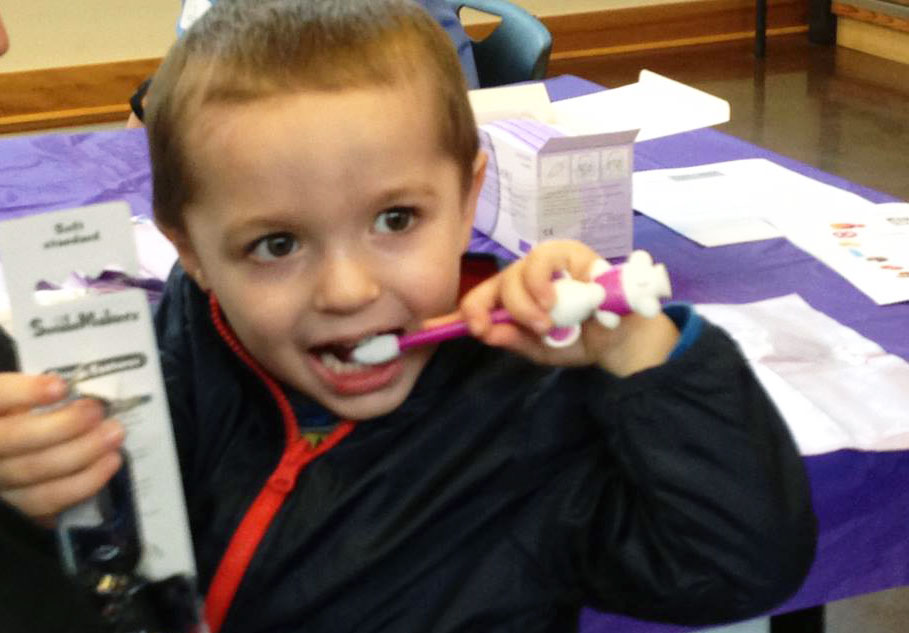
The sooner children begin getting regular dental checkups, the healthier their mouths will stay throughout their lives. Early checkups help prevent cavities and tooth decay, which can lead to pain, trouble concentrating and other medical issues. Youngsters with healthy teeth chew food easily, learn to speak clearly and smile with confidence.
The American Dental Association and the American Academy of Pediatrics say that every child should visit a dentist by age 1 – or as soon as the first tooth appears. This “well baby visit” teaches parents and caregivers how to care for their children’s teeth and help them remain cavity-free.
For example, pediatric dentists see many young patients with cavities that came from falling asleep with a bottle of milk or juice. The dentist can tell the parent or caregiver:
- Why this causes decay
- The importance of encouraging children to drink milk, water and juice from a cup as they approach their first birthday
- How to brush young teeth.
Dentists also encourage mothers to stop on-demand nighttime breastfeeding, after the child’s first teeth come through.
Tooth decay is the most common chronic disease among children in the United States. The Centers for Disease Control and Prevention (CDC) reports that more than 40 percent of children have decay by the time they reach kindergarten.
Here in Washington State, nearly 60 percent of elementary school-age children suffer from preventable dental decay. More than one in five have cavities in at least seven teeth.
The Center for Pediatric Dentistry provides gentle, expert care to all children through age 18. Specialty clinics offer comprehensive services for children with special needs and those who have medical problems, such as cancer.
For more information or to make an appointment, call 206-543-5800.
- Skip to primary navigation
- Skip to main content
- Skip to primary sidebar
Teaching Expertise
- Classroom Ideas
- Teacher’s Life
- Deals & Shopping
- Privacy Policy
Dental Activities For Preschoolers: Crafts, Games, And Educational Worksheets
January 11, 2024 // by Eileen Zajac
Educational activities that teach your children about proper tooth brushing practice will help them to develop strong oral health habits. Starting the practice now is a surefire way to make this a life-long habit for them. We’ve compiled a list of 35 exciting and innovative dental activities that are sure to help your preschoolers see the benefits of brushing and get them informed on the best brushing techniques! Grab your toothbrush and let’s get started!
1. Brush Away Practice
How do you combine math and dental hygiene? SIMPLE! Look at this fun shape brushing activity that includes both preschool math and preschool brushing techniques. Your kiddos will love this fun activity where they’ll need to brush the target shapes off their teeth! All you’ll need is the printout, a drywipe marker, and a plastic wallet.
Learn More: Twinkl
2. Dental Scissor Skills
Incorporate building motor skills in your dental health activities this year! Have your students cut out toothbrushes and teeth to make a whole class collage! You could also draw some shapes and lines onto the brushes and teeth for them to cut along and master those scissors skills!
Learn More: Instagram
3. Dental Matching
A simple matching activity is the perfect choice for preschoolers. Get them familiar with all the different care resources we have to use on our teeth. From dentists to dental floss, see how many of these items and terms they’re familiar with!
4. Toothbrush Patterns
Practice patterns with your kiddies with this dental health-themed activity! Simply print, laminate, and cut up the different pictures and have your students copy or repeat the pattern. This works great for stations and even team building if you get your kids working together in groups!
Learn More: Teachers Pay Teachers
5. Lamination Brushing
Turn teeth brushing into a game! With something as simple as a laminated printout of some teeth, your little ones can use real toothpaste and toothbrushes to practice their circular brushing motions to scrub off the germs and bacteria!
Learn More: Made By Teachers
6. Playdough Teeth
Make some excellent model teeth for your classroom simply out of red or pink playdough and beans! Challenge your kiddos and have them help you to count out the correct number of teeth to put in the correct spots.
Learn More: Pinterest
7. Counting Teeth
Here’s another activity to improve your learners’ counting abilities! Clever resources like these little plastic teeth can be used for so many different activities, including this one! Use the printout and have your students place the correct number of teeth in each mouth. If you don’t have any plastic teeth, you could use mini marshmallows.
Learn More: Tot Schooling
8. Read and Brush!
We all know how important it is to incorporate literacy activities into our daily classroom routine. Using a book like Snappy Croc in your dental health lesson plan is sure to enhance your student’s understanding and learning! Your preschool learners in particular will really benefit from a fun shared story to pick up on the theme you’re covering in class.
9. Paint a Tooth
Is there anything preschoolers love more than getting messy? Make this tooth white and get hands-on with some paint in the process. Your little learners will absolutely love the novelty of getting to paint with toothbrushes! It will help them practice their brushing techniques while also making super cute dental crafts to display in the classroom.
Learn More: Play To Learn Preschool
10. Glue, Draw & Brush
Building motor skills and strong teeth are the main focus of this activity! Let your kiddies build an alligator with a mouth full of teeth. They’ll need to be focused and precise as they add glue to the teeth and fix them in the right place in the alligator’s mouth.
11. Floss, Floss, and Floss Some More
Flossing is an important aspect of dental hygiene! Grab some large building blocks then pack some Play-Doh in the gaps. Next, give your kiddies some floss and let them work at getting the Play-Doh out of the gap. This practice activity is a super way to help your little ones get a basic understanding of why it’s important to floss your teeth and remove all those pesky bits of food and plaque!
Learn More: Sugar Spice And Glitter
12. Pom Pom Fun
Another flossing activity that might be a bit easier and less messy than the Play-Doh version, is to use pom-poms instead of Play-Doh. This option is better for younger learners and is another perfect way to have them practice and finesse their motor skills.
13. DIY Brushing Model
A hands-down favorite dental health activity is this DIY mouth model! Built out of some red and pink craft paper and mini marshmallow teeth, these cute models can be used to brush and display! Your little ones will have so much fun!
14. Toothy 2D Shapes
Cut and stick activities are a simple, low-prep activity for preschoolers. Have your students cut out the teeth and then let them match the shape of the item on each tooth to the corresponding shape sheet. This dental health printable is definitely one to keep on hand as it’s super easy to set up for your kiddos!
15. Brush Santa’s Teeth
Hands-on learning activities have proven time and time again to have a better outcome on student understanding. Brushing Santa’s teeth is one way to practice their brushing techniques around the holiday season! Laminate this Santa printable then add some germs and food in the form of a drywipe marker. Then give your kiddies a toothbrush and some toothpaste (or shaving foam) and put them to work!
Learn More: TES
16. Good and Bad Sort
Instilling healthy habits in our little ones is super important for their growth and dental health. One way to do that is to teach them about what foods are healthy and which are unhealthy for their teeth. Use this activity to have them separate foods that are good and bad for teeth and talk about how they actually affect your teeth.
Learn More: The Printable Princess
17. Brushing Time Line Tracing
Simple dental health worksheets can sometimes be all you need to get your kiddos thinking about their own dental health. Spark the conversation of what they use and need in their homes to make sure their mouths are healthy with this line-tracing activity. Not only will this worksheet improve their knowledge of dental health, but it’ll also help their motor skills and pencil grip!
Learn More: Planning Playtime
18. Dental Letter Find
Alphabet worksheets are a staple in the preschool classroom so why not use one that matches up with teaching hygiene to preschoolers? Simply give your kiddos the printout and have them use bingo dabbers or markers to color each letter in as they pick up the letter cards. This tooth-themed activity is a perfect way to tie in some literacy learning and letter recognition with your topic.
Learn More: Live Laugh Love Kindergarten
19. Flossing Fun Bulletin Board
Teaching proper teeth hygiene starts with positive reinforcement! Clever ideas like this flossing fun bulletin board send a positive message to all of our little minds by allowing them to have a go at this fun activity every time they pass by! Simply let your kids make these mouth models from paper and styrofoam, then pin them to the board with some string!
20. Plastic Bottle Tooth Craft
A fun way to promote recycling, these fun tooth models are created from used plastic bottles! A bit of white paint, some fun face cutouts, and colored markers are all you need to create models of happy, healthy teeth with your students. You might want to precut the bottles for your preschoolers and be sure to tape up any sharp edges.
Learn More: Truly Handpicked
21. Dental Health Sliding Sequence Activity
This fun activity is not only educational but it also gives your kiddos a helpful tool! This sliding window paper craft gives your learners a visual of the steps they need to take to keep their teeth happy and healthy. This activity is also a great way to introduce them to the concept of sequencing. Simply print off the template and help your kids to cut out and assemble it!
Learn More: Kindergarten Worksheets And Games
22. Dentist’s Surgery Dramatic Play
The dentist will see you now! This classy dental office dramatic play kit is perfect for creating your own Dental Health Dramatic Play Center. Printable signs, a helpful word wall, and other pretend dentist office printables are a fun way to dress up your play center and have your kiddies explore the concepts related to dentistry!
Learn More: Teach Starter
23. Dental Health Pocket Chart Sort
Sequencing and sorting are the basis for this engaging dental health activity! Simply set up these picture cards and a pocket chart and give your little ones a go at ordering the steps in brushing their teeth and identifying tooth-friendly foods!
Learn More: Mrs. Richardson’s Class
24. Blippi’s Toothbrushing Song
Blippi is a favorite among preschoolers everywhere! Get your kiddies up and moving with this fun song about tooth brushing from Blippi! This catchy tune will make it super easy for them to remember the steps they need to take to care for their teeth. You might even find yourself humming this one after school!
Learn More: YouTube
25. Pretend Play Kids Dentist Kit
This fun playset will make your preschoolers feel like real dentists! This kit is the perfect addition to your dentist’s surgery play center and will have your kiddos acting like the real deal. They won’t be able to contain their excitement when you put these dental tools into their hands and they’ll soon be taking their oral health a whole lot more seriously.
Learn More: Sweet House Reborns
26. Race to Lose a Tooth Game
This preschool game sets the foundation for subtraction! With each roll, they’ll take off the number of teeth as shown on the dice. Use mini marshmallows and a die, and have your race to lose all of their teeth to win this dental math game!
Learn More: Toddler Approved
27. Craft a Cute Happy Tooth
Add this craft to your preschool lesson plans during your dental health topic! These cut-out templates turn simple paper into a fun, smiling tooth craft to remind your students to brush and keep their teeth happy!
28. Healthy and Unhealthy Tooth Collage
Recycled magazines, newspapers, and tooth cutouts are all you need for this dental health lesson. Have your kiddies cut out pictures of food and drinks, then sort them to show which ones are healthy and unhealthy for their teeth. Such an easy and effective preschool lesson plan!
29. Pulling Teeth Station
If you’re looking for fun ideas for STEM activities for your classroom, look no further! Using Play-Doh and small aquarium rocks, your little dentistry students will start pulling teeth. This engaging STEM station is perfect for building your learners’ fine motor skills and trying out a bit of dental work for themselves.
Learn More: Things To Share And Remember
30. Dental Health Playdough Mats
These fun playdough mats are a great way to build fine motor skills during Children’s Dental Health Month! Laminated picture cards set the foundation for children to squish, mold, and shape their way to becoming experts in how to look after their smiles!
31. Tooth Graphing
This fun activity is a foundational math concept that’s perfect for preschoolers! Have your littles look at pictures, count the teeth, and make their own graph using mini marshmallows to compare. It’s the perfect blend of math and dental health, making this activity an ideal choice for Dental Health Month!
Learn More: Pocket Of Preschool
32. Roll, Count, and Cover Tooth Activity
This fun math game only requires a few basic materials to create a fun cotton ball tooth craft! Using a tooth-shaped number mat, this activity encourages your kiddos to roll a die, count the dots, then identify the number and cover it on the tooth mat. It’s a perfect way to build number identification and counting skills.
Learn More: Teachers Mag
33. Happy Tooth Hanging Craft
What’s better than making a tooth? Making a happy tooth of course! This cute toothy craft is a fun way to create a memorable reminder for your learners to keep their teeth healthy by brushing. Use some tooth printables to create this adorable 3D hanging tooth!
Learn More: Fun Learning Life
34. Sing a Dental Health Song
Music is always a great way to get your little ones to engage with a topic and remember things! This fun tooth song is sure to get your class singing, brushing, and flossing their way to good dental health!
Learn More: Preschool Teacher 101
35. Dental Health Color Match Activity
Take Dental Health across the curriculum and use what your students are learning to branch into other concepts like learning their colors. This fun color-matching activity introduces your kids to dental tools and helps them review their color identification skills by having them stick them onto the corresponding color card.
Learn More: Messy Little Monster
- U.S. Department of Health & Human Services
- Administration for Children & Families
- Upcoming Events
Brush Up on Oral Health
- Open an Email-sharing interface
- Open to Share on Facebook
- Open to Share on Twitter
- Open to Share on Pinterest
- Open to Share on LinkedIn
Prefill your email content below, and then select your email client to send the message.
Recipient e-mail address:
Send your message using:
Talking with Children About Dental Visits

Tips for Head Start Staff to Share with Parents to Prepare Children for Dental Visits
Follow these tips to prepare children for dental visits:
- Be positive. Dental visits are easy and painless for most children. Suggest that parents use positive statements about what will happen during a visit. For example, say, “The dentist will see what a good job you do taking care of your teeth” or "When you leave the dental office, your teeth will be nice and clean.”
- Keep it short and simple. If children ask what will happen during the dental visit, advise parents to give a short, simple answer. For example, parents can say, “The dental hygienist will count how many teeth you have.” Sharing too much information about dental visits may confuse and worry children.

- Tell parents to keep their fears to themselves. If parents have fears about dental visits, tell them not to share their feelings with their child. Hearing about adults’ fears can make children afraid of dental visits too.
- Role-play visiting the dentist and dental hygienist. Tell parents to have children dress up and pretend that they are dentists or dental hygienists. Children can use white shirts as lab coats, paper napkins as patient bibs, and coffee filters and yarn as masks. Advise parents to let children pretend to examine and count their parents’, sisters’, or brothers’ teeth.
- Sesame Street in Communities’ Oral Health webpage has games, videos, and more on that can be used to talk to children before and during a dental visit.
- Make dental visits fun. Encourage parents to have children bring a favorite stuffed animal or blanket to the dental visit. Let children wear a special outfit or costume to the visit. Also, suggest that parents plan a fun activity after the visit.
Download a PDF version to print and share.
Resource Type: Article
National Centers: Health, Behavioral Health, and Safety
Audience: Teachers and Caregivers
Series: Brush Up on Oral Health (BUOH)
Last Updated: April 25, 2023
- Privacy Policy
- Freedom of Information Act
- Accessibility
- Disclaimers
- Vulnerability Disclosure Policy
- Viewers & Players
- Skip to content
- Skip to navigation
Children’s teeth development
Children’s baby teeth can arrive in any order, although the lower incisors are often first, followed by the upper incisors. The first molars are usually next, followed by the canines and second molars.
All 20 baby teeth usually arrive by the time children are 3 years old.
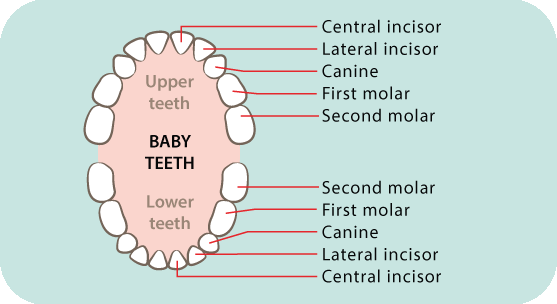
Dental care: keeping children’s teeth clean
Brush your child’s teeth twice a day – morning and night. Use a pea-sized amount of low-fluoride toothpaste on a child-size toothbrush, unless your dentist recommends otherwise.
Your child might want to start helping to clean their own teeth. You can let your child hold the toothbrush and try brushing their own teeth first. This will help your child feel they’re part of the action. After they’ve had a go, you can finish and make sure that all tooth surfaces are brushed properly.
Also encourage your child to rinse their mouth with water after lunch and snacks. This helps to wash away any leftover food.
Your child needs your help and supervision with keeping teeth clean until they’re about 8 years old.
Just keeping teeth clean isn’t a guarantee against tooth decay – diet is also important. Avoid giving your child sugary foods and sugary drinks like fruit juice, soft drink and flavoured milk.
The best way to brush children’s teeth
You might like to try the following routine when brushing your child’s teeth:
- Stand or sit behind your child so your child feels secure. Brushing teeth in front of a mirror is good too, because it lets you see your child’s mouth.
- Cup your child’s chin in your hands, with their head resting against your body.
- Angle the bristles of the toothbrush towards the gum. If you’re using a manual toothbrush, move the brush in gentle circles. If you’re using an electric toothbrush, move the brush gently across the teeth.
- Brush the outer and inner sides of the teeth and along the gumline. Brush along the chewing surfaces of the teeth.
- Gently brush your child’s tongue.
- After brushing encourage your child to spit out toothpaste, not swallow it. There’s no need to rinse after brushing because the fluoride toothpaste left behind protects your child’s teeth.
Children are more likely to go along with cleaning teeth if it’s fun and part of a daily routine. For example, you can sing ‘This is the way we brush our teeth, brush our teeth, brush our teeth’ while you’re brushing. Or you could pretend the toothbrush is a train, saying ‘Toot toot chugga chugga’ as you move it around your child’s teeth.
Toothbrushes: choosing and keeping them clean
Choosing a toothbrush It’s important to choose a toothbrush designed especially for children aged 2-5 years. These toothbrushes have small oval heads, soft bristles and non-slip, cushioned handles. They also often have cartoons and fun designs on the handle, which your child might like.
Electric and manual toothbrushes are equally good, as long as you use them properly to clean all the surfaces of all your child’s teeth. If you’re deciding between a manual and an electric toothbrush, it’s OK to let your child choose.
Keeping the toothbrush clean After cleaning your child’s teeth and gums, rinse the toothbrush with tap water. Store the toothbrush upright in an open container to allow it to air-dry.
You should replace toothbrushes every 3-4 months, or when the bristles get worn or frayed.
Cleaning and caring for children’s teeth early on sets up good dental habits for life.
Fluoride and dental care
Fluoride is a mineral that keeps teeth strong and prevents tooth decay . Fluoride is safe and works best when your child gets it in very small amounts throughout the day in:
- toothpaste – your child can using a low-fluoride toothpaste from 18 months.
- tap water – most tap water in Australia has added fluoride.
- foods containing fluoride, like fruit and vegetables.
Visiting the dentist
At this age, children should visit the dentist regularly. Talk to your dentist about how often your child needs a check-up. Dentists usually recommend every 6-12 months.
Regular dental check-ups give your child the chance get to know the dentist. They also give you and your dentist a chance to talk about your child’s dental health needs and plan your child’s dental care.
Your child might also see other oral health professionals, depending on your child’s needs. These include dental therapists , dental hygienists and oral health therapists or specialist dentists like paediatric dentists.
Dental care in Australia
Dental care for children is often free in the public dental system , up to a certain age. For details of public dental providers, see your state or territory health department website.
There are private dental clinics all over Australia. You’ll have to pay for your appointments, but people with private health insurance might get some money back from their private health fund.
If you’re eligible, the Australian Government’s Child Dental Benefits Schedule covers basic dental services for children aged 0-17 years at most private and public dental clinics.
Burlington & Cold Spring, KY Pediatric Dentist » Blog » Importance of Early Dental Visits for Children: A Guide for Parents
Importance of Early Dental Visits for Children: A Guide for Parents
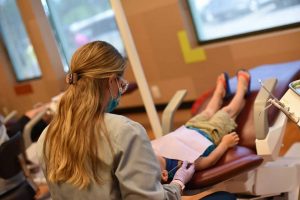
Age Recommendations for First Dental Visit
It’s a common query among parents — when should my child first see a dentist? The answer might surprise you. The American Academy of Pediatric Dentistry and the American Dental Association recommend a child’s first dental visit should occur by the age of one or within six months after the first tooth erupts. This early introduction to the dentist is not just a formality; it’s foundational to your child’s oral health.
Why so young? These visits allow the dentist to get ahead of any potential problems and help your child become accustomed to regular dental check-ups from an early age, thwarting fears that might otherwise blossom if the first visit is due to pain or discomfort.
Benefits of Early Dental Visits
The benefits of early dental visits extend far beyond the dental chair. Not only do they provide essential preventive care and the opportunity for early intervention, but they also offer an invaluable platform for educating parents (and eventually your child) on proper oral hygiene practices.
Preventive Care and Early Intervention
By the time most children reach the age of one, they have some teeth, setting the stage for potential oral health issues. Dental professionals use this first visit to examine your child’s mouth, clean their teeth, and provide fluoride treatments to help reduce the risk of cavities. Early visits can also identify issues with your child’s teeth or gums, like teething problems or issues with bite alignment, and stop them from becoming more severe.
Monitoring Growth and Development of Teeth
Early dental visits help to monitor the development of your child’s teeth, ensuring they’re growing properly and without any signs of decay. For example, did you know that baby (primary) teeth can affect a child’s speech development, ability to chew and eat, and even the alignment of adult teeth? They’re not just temporary placeholders; they’re critical to your child’s overall health and well-being.
Education on Proper Oral Hygiene Practices
The first dental visit is also a parent’s primer on protecting those pearly whites. Dentists share insights on habits such as brushing, flossing, and healthy dietary choices, tailoring their advice to your child’s specific needs. The take-home message? Establishing a solid dental care routine early can set your child up for a lifetime of healthy smiles.
Common Concerns Addressed
Many parents feel a mix of apprehension and confusion about their child’s dental visit. Will my child cooperate? What if they’re scared? Here are some common concerns addressed to help put any pre-visit jitters at ease.
Addressing Parents’ Concerns About Children’s Dental Visits
It’s natural to feel concerned about your child’s reaction to their first dental visit. Rest assured, pediatric dentists are specially trained to care for children and make the experience as positive and comfortable as possible. They know how to engage with children, using child-friendly language and a gentle approach to alleviate any worries.
Tips for Making the Dental Visit Positive and Comfortable for the Child
Start by introducing the concept of a dentist early on, long before the appointment is scheduled, to normalize and even make it exciting. Role-playing dentistry at home can make the experience seem less foreign to your child. On the day of the visit, bring along your child’s favorite toy or comfort item, and choose an appointment time when they’re likely to be well-rested and cooperative.
Understanding the critical role of early dental visits is a significant step in securing your child’s oral health. As a parent, your diligence in this area promises your child the comfort of good dental health habits, and ultimately, lays the ground for a lifetime of smiles, laughter, and the confidence that comes with a healthy smile. Be proactive, be informed, and start early — your child’s dental visit could just be the best “first” you’ve ever arranged.
Contact the Pediatric Dental Center for a positive dentist experience!
5495 N Bend Rd Ste 102 Burlington, Kentucky 41005 Phone: 859-534-5640
220 thomas more pkwy crestview hills, ky 41017 phone: 859-341-3012, 418 cross roads blvd cold spring, ky 41076 phone: 859-341-3012.
Cold Spring
Questions? Send Us a Message!
Name: Email: Phone: Select Office: —Please choose an option— Burlington Cold Spring Unsure
Message: Please leave this field empty. Please leave this field empty.
TEXT OUR OFFICE
Text message is limited to 160 characters.
- Enter your Name.
- Enter your Cell Phone Number, area code first
- Enter your text message in the box.
- Click "Send Text"
- A copy of this text will be sent to the office and to your cell phone. The office's reply will also be sent to your cell phone where you can continue the text conversation.

COMMENTS
Dentist Visit: Invite a Dentist or Dental Hygienist to visit the classroom and discuss Dental Health. Have questions prepared in advance from the children including all the questions they have about teeth!
Your child's first dental visit is to help your child feel comfortable with the dentist. The first dental visit is recommended by 12 months of age, or within 6 months of the first tooth coming in. The first visit often lasts 30 to 45 minutes.
A collection of 20 activities and ideas exploring teeth and dentists for a dental health theme for preschool, pre-k, and kindergarten classrooms.
I have created a list of SIMPLE dental health themed activities that are doable and FUN! This simple activity plan can be printed and used as a guide to help add hands-on learning activities to your week.
The American Dental Association and the American Academy of Pediatrics say that every child should visit a dentist by age 1 – or as soon as the first tooth appears. This “well baby visit” teaches parents and caregivers how to care for their children’s teeth and help them remain cavity-free.
A simple matching activity is the perfect choice for preschoolers. Get them familiar with all the different care resources we have to use on our teeth. From dentists to dental floss, see how many of these items and terms they’re familiar with! Learn More: Twinkl. 4. Toothbrush Patterns.
Going to the dental office or clinic is a new and unfamiliar experience for children. Learn tips for helping young children prepare for a dental visit.
Key points. Children should have regular dental check-ups every 6-12 months. To prevent tooth decay, brush teeth twice a day and avoid sugary foods and drinks. Use low-fluoride toothpaste unless a dentist advises otherwise. On this page: Children’s teeth development. Dental care: keeping children’s teeth clean.
Dental professionals use this first visit to examine your child’s mouth, clean their teeth, and provide fluoride treatments to help reduce the risk of cavities. Early visits can also identify issues with your child’s teeth or gums, like teething problems or issues with bite alignment, and stop them from becoming more severe.
Prepare a preschooler or older child for the visit by giving them a general idea of what to expect. You can tell them about the exam room, the instruments they might see, the face masks the dentist and hygienist may wear, and the bright exam light. Explain why it is important to go to the dentist.